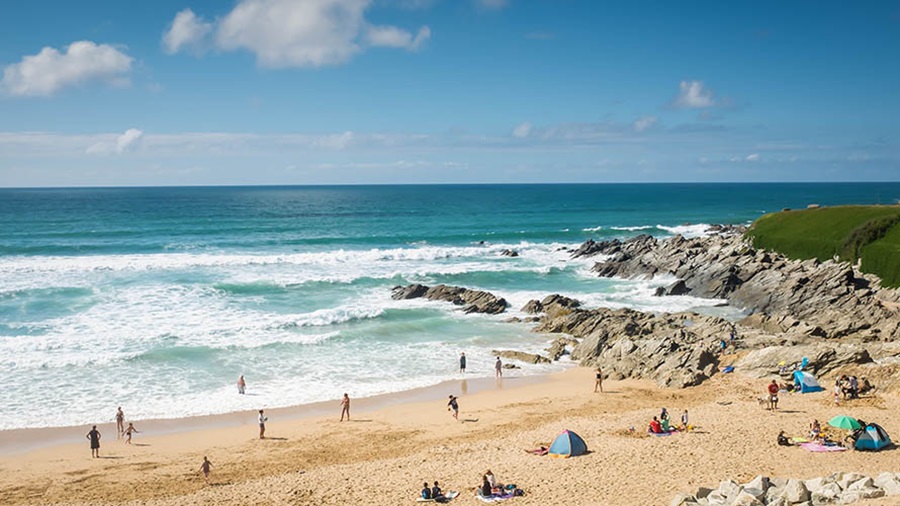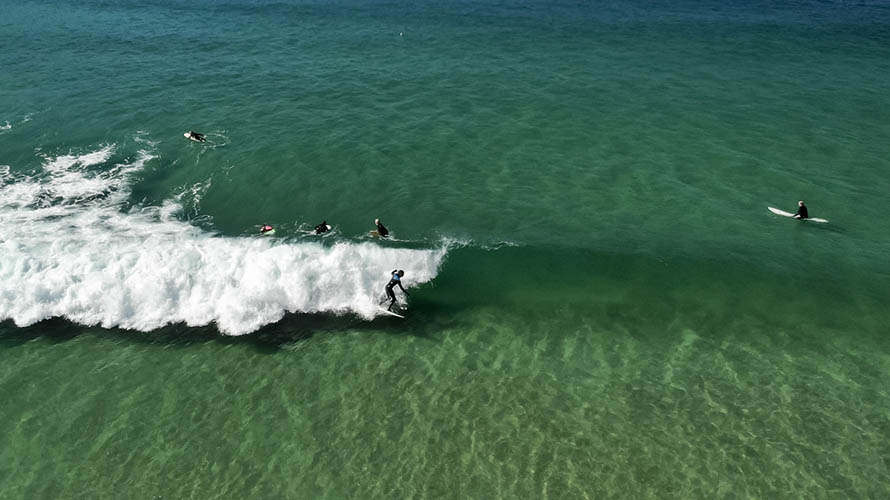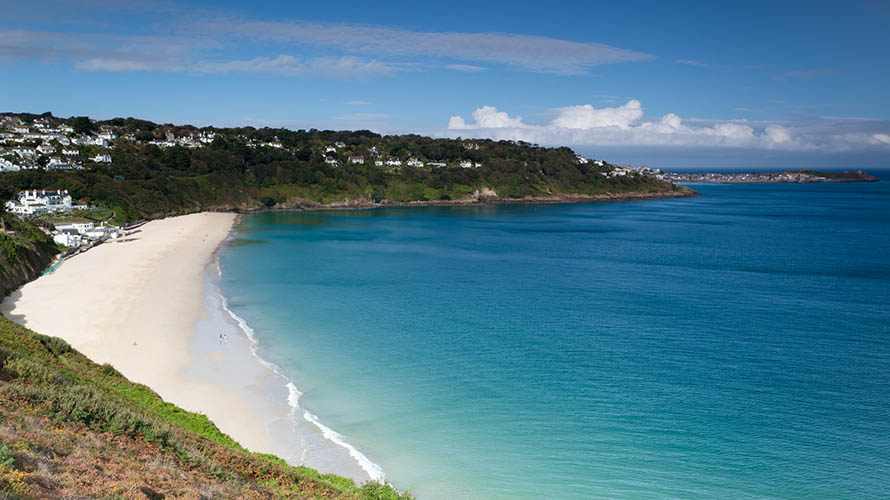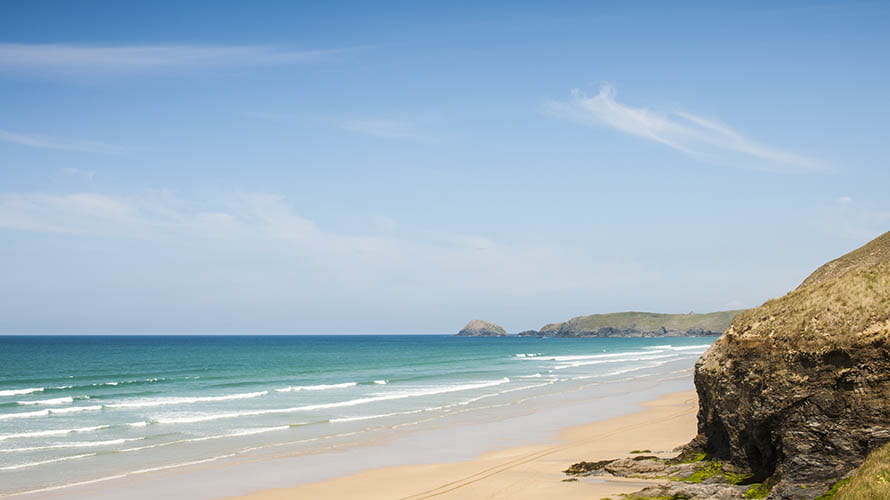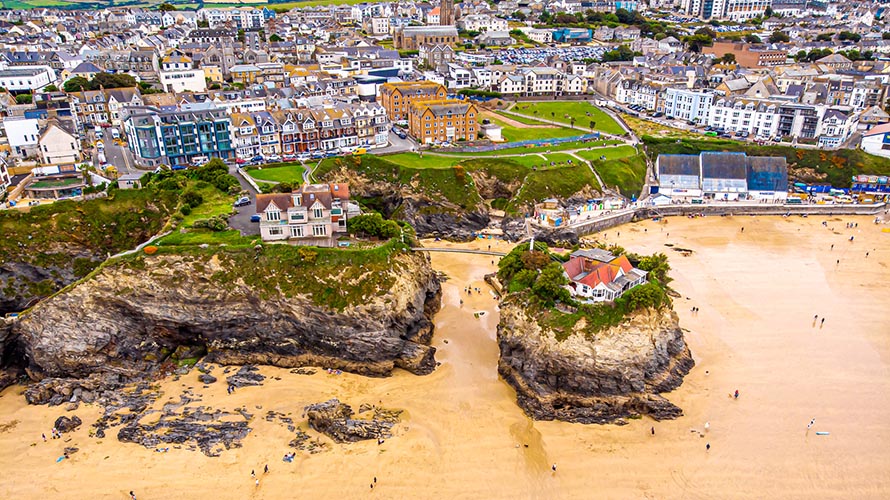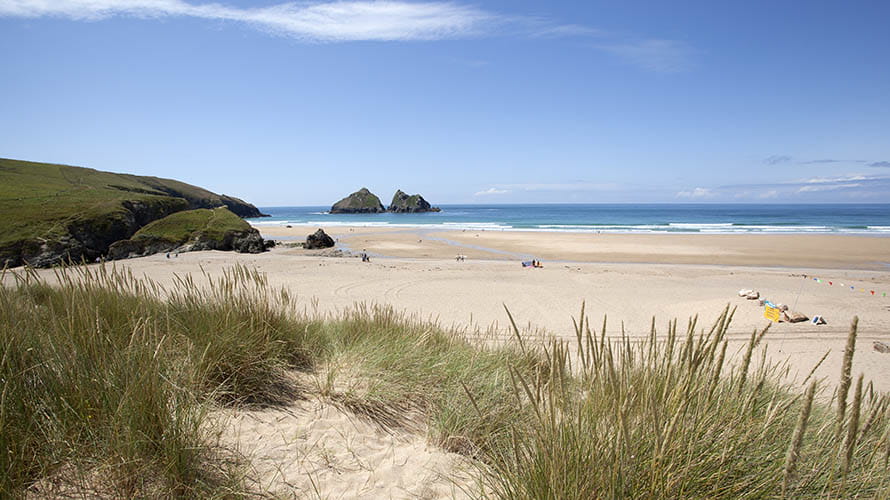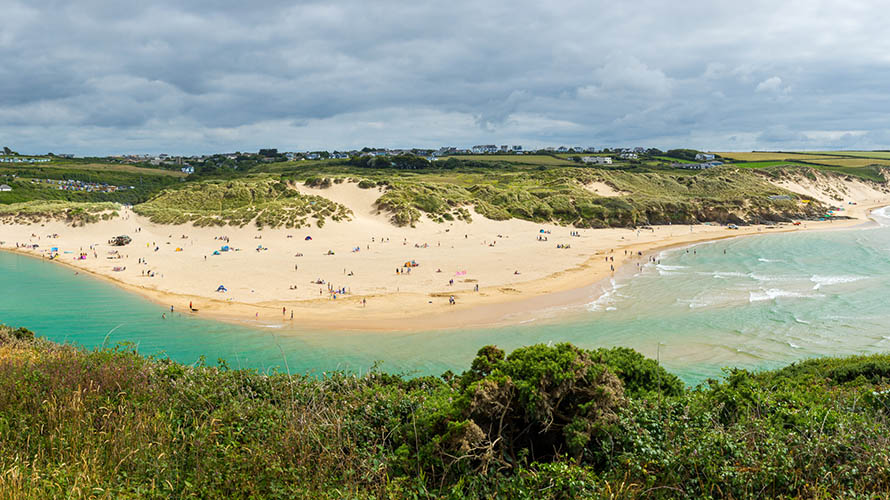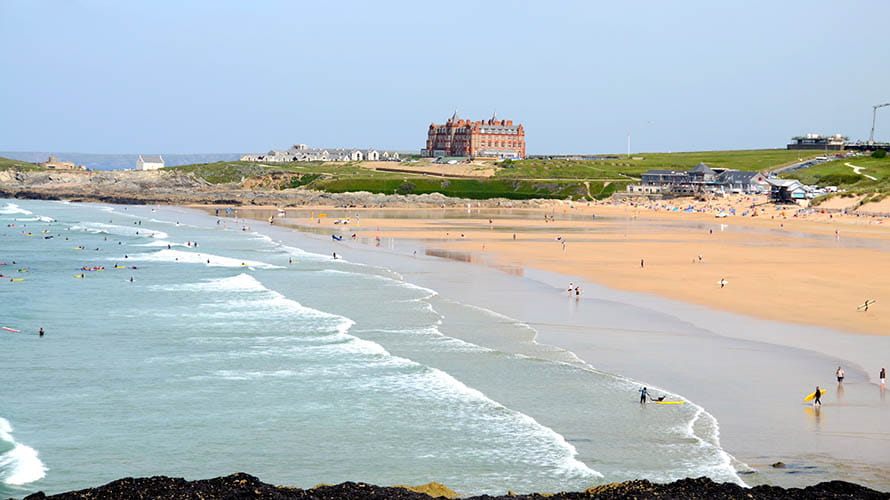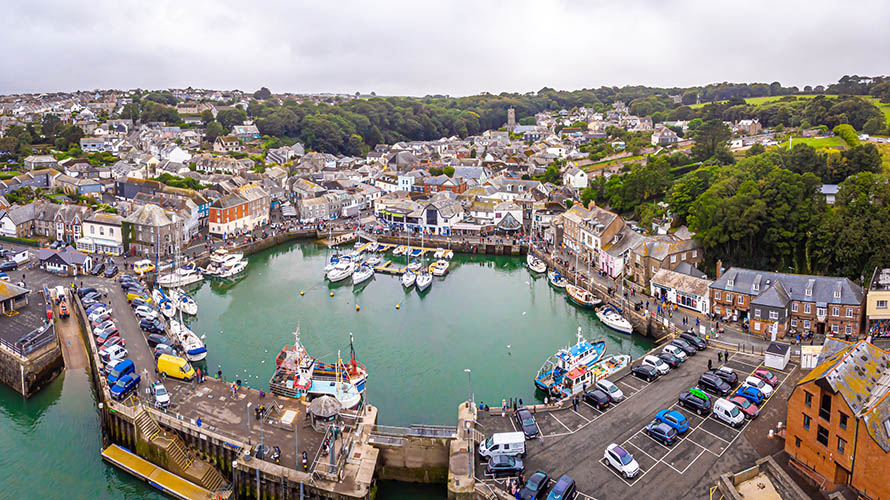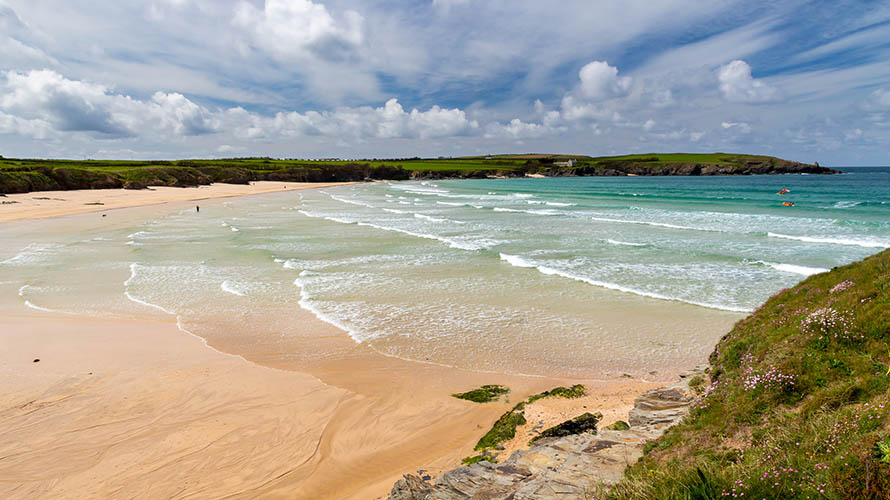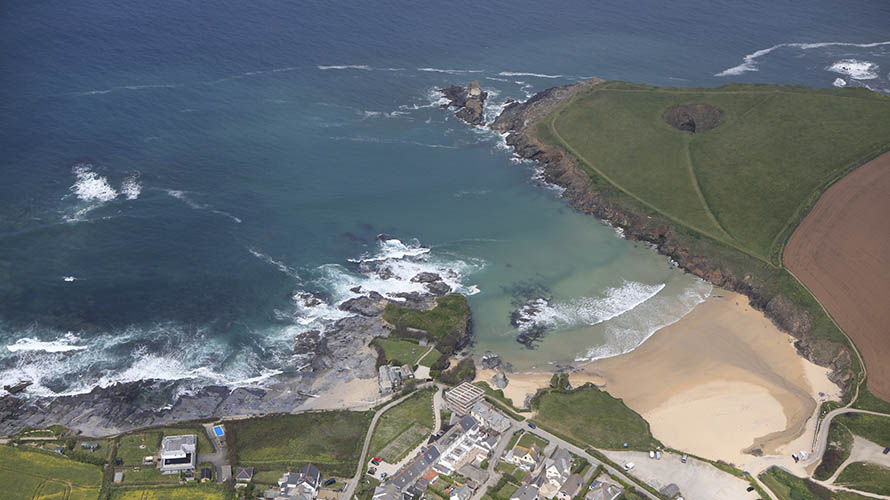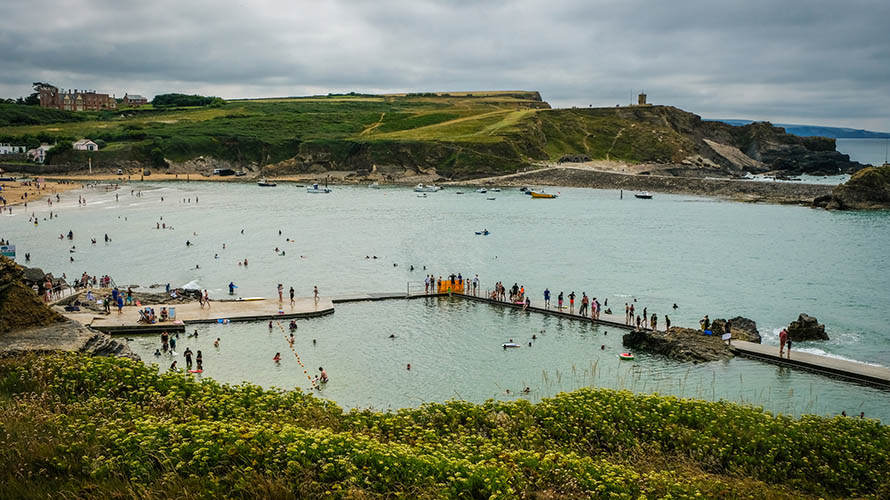By Parkdean Resorts on 11/04/2024
From Land’s End, England’s most westerly point, to the Marsland Valley on its eastern border with neighbouring Devon, Cornwall’s northern coastline offers up an abundance of beaches of every shape and size. Today, we’re taking you on a road trip from end to end - sifting out the cream of the crop in our hand-picked selection of North Cornwall’s best beaches.
What makes North Cornwall’s beaches so brilliant?
North Cornwall’s coastline faces both the Atlantic Ocean to the west and Celtic Sea to the north. Its exposed position has resulted in its rugged and dramatic profile, with jagged headlands punctuated by deep sandy coves. Throughout its shoreline, wherever there’s shelter from the force of the Atlantic, you’ll find a peppering of vibrant coastal towns and harbour villages.
You can’t cover North Cornwall’s beaches without mentioning surfing, perhaps what the coastline is most famous for, with surfers from all over the globe travelling to North Cornwall’s shores in search of the ultimate break. The region's distinctive deep and narrow bays are honed to channel and direct rolling waves up their gently sloping shores, and a number of Cornwall's west-facing bays are considered amongst the best beaches in Europe for surfing.
If Surf’s a laundry detergent in your household, don’t worry, there’s still plenty of room on Cornwall’s north coast for swimmers and beach bums too - and our list has got you covered. Many of the region’s beaches are sheltered from the prevailing westerly winds and offer beautifully calm waters, ideal for snorkelling, sunbathing and all things civilised.
Surfers lining up to catch the perfect wave on Fistral Beach in Newquay
Is North or South Cornwall better?
We often get asked whether North or South Cornwall is better; the honest answer is they’re both brilliant when it comes to beach holidays. And thanks to the county’s small size and great road network, you don’t have to choose between North and South Cornwall. You can see and experience it all, comfortably, within a week’s holiday with a little bit of planning and some keen driving. Check out our guide to Cornwall’s best places to stay to get planning your break.
You could argue that north Cornwall tends to be busier, with bigger lively tourist towns like Newquay and St Ives attracting the lion's share of visitors. However, there are no rules about having to stick to the beaten track, and you’ll find everything from busy family beaches to deserted hidden coves on both coasts if you look in the right places.
If you’re planning the full circuit, don’t forget to check out our guide to the top beaches in South Cornwall for the complete list of Cornwall’s best beaches.
Land’s End Peninsula
Officially designated Penwith (Cornwall’s most westward National Character Area), Land’s End Peninsula sits at the very tip of Cornwall, jutting out towards the Atlantic Ocean beyond. While Land’s End itself is a popular tourist hot spot, we’re on the hunt for beaches - and Cornwall’s northern coast delivers right out of the gate.
Dramatic rock formations off Land's End, the most western point of England's mainland
Sennen Cove Beach
Just a few minutes north of Land’s End and our beach tour begins. Sennen Cove Beach is a long sweeping bay of golden soft sand. Its north-western orientation makes it a popular spot for surfers, drawing in rolling waves from the Atlantic. However, the southern end of the beach enjoys shelter from the lifeboat station’s pier and a designated safe swimming area is marked by flags throughout the summer season. There are three car parks just off Cove Hill road, all just a short stroll from the beach, so park up wherever you can find a space.
- Seasonal dog ban in force between May and September 10am-6pm
The village of Sennen Cove at the south-west end of Sennen Cove Beach
Portheras Cove Beach
Following the craggy coastline of the Penwith Peninsula around the tip and onto Cornwall’s true north coast, the first beach you’ll come to is Portheras Cove. As one of Cornwall’s most isolated beaches, it’s often missed by the tourist crowd and is a favourite amongst locals. While not recommended for swimming due to its strong currents and lack of lifeguards, it’s the perfect place to escape for a private paddle or picnic. Seals are often spotted at Portheras too, so you might have some company after all! We recommend parking up at Pendeen Lighthouse for spectacular headland views. Follow the path along to Boat Cove then switch to the South West Coastal Path which takes you around to Portheras.
- Dog friendly year-round
The grassy path from Pendeen Lighthouse leading down to Portheras Cove
Between Portheras and St Ives, Cornwall’s coastline becomes increasingly rocky and inaccessible, however, there are some spectacular isolated and wild beaches waiting for those who seek them out. If you can make it to the likes of Veor Cove, it’s highly likely you’ll have the whole beach to yourself, even in the height of summer. They truly are hidden gems and usually only frequented by hikers along the South West Coastal Path, or the odd naturist!
St Ives Bay
Heading further west along the north shore, St Ives Bay is where North Cornwall really starts pulling out the big guns. St Ives is one of the UK’s most beloved holiday destinations, and serves up a melting pot of culture, history, restaurants, galleries and, of course, truly excellent beaches. From fine dining and art to fish and chips and playgrounds, St Ives has something for everyone.
Thanks to the bay’s unique geography, you’ll find both north-west and north-east facing beaches in St Ives, with its exposed shores providing perfect waves for surfers and its sheltered sands ideal for families and swimmers.
Colourful houses poised around the turquoise waters of St Ives Harbour
Porthmeor Beach
The first of St Ives’ beaches is the Blue Flag awarded Porthmeor Beach. Slap bang in the centre of St Ives, right in front of the Tate gallery, Porthmeor’s western orientation exposes it to the waves of the Atlantic - making it a favourite amongst surfers. As one of the town’s main beaches it can get extremely busy in peak season so arrive early and stake out your spot with a picnic blanket if you’re visiting during the summer.
- Seasonal dog ban in force between May and September 10am-6pm
Looking down on to Porthmeor Beach from St Ives' headland
Top tip: Parking in St Ives can be hard to come by, especially during the warmer months. If you're staying in the town, we recommend exploring on foot, as all of the town’s local beaches are just a short walk away. Alternatively if you need to park, arrive early and head to Trenwith car park, which operates a park and ride bus service into the town.
Porthminster Beach
Arguably one of the best beaches in Cornwall, Porthminster Beach looks out east across St Ives Bay, towards Godrevy Lighthouse - a view which inspired Virginia Woolf to write her novel ‘To The Lighthouse’. A consistent Blue Flag winner, Porthminster is backed with lush greenery, including palm trees unique to St Ives’ microclimate, and offers up powder-soft golden sand and shallow waters, ideal for swimming. As with all of St Ives’ central beaches, you’ll find great facilities and amenities available nearby.
- Seasonal dog ban in force between May and September 10am-6pm
Looking east over Porthminster Beach as bathers enjoy the warm waters
Carbis Bay Beach
Thrust into the global spotlight during 2021’s G7 Summit, it’s easy to see why Carbis Bay Beach was chosen as the backdrop for the summit’s official photo op. If you’re going to choose a British selfie spot for world leaders, it’s a pretty tough one to beat! Just a couple of miles outside of St Ives, this wide, powder-sand beach is yet another of North Cornwall’s Blue Flag winners. Its sheltered position means its waters stay relatively calm all year, making it ideal for families with kids who want to swim. Parking can be found at Porthrepta car park just under 10 minutes’ stroll away, but be warned, it’s a steep road down to the beach that will challenge even the sturdiest of flip-flops.
- Seasonal dog ban in force between May and September 10am-6pm
Pristine Carbis Bay Beach, with the town of St Ives visible in the next bay along
With so many beaches in such a short stretch of coastline, you really are spoiled for choice in St Ives. Small and sheltered Porthgwidden Beach, nestled between Porthmeor and the harbour, is a popular choice for families and is well worth a visit. Further west out of St Ives, but still within easy shooting distance, you’ll find Porthkidney Beach and The Towans (a collection of dunes and beaches sweeping along miles of open bay), which offer a huge expanse of sand at low tide. They’re a great choice if you want to escape the crowds of St Ives’ main beaches.
Perranporth
Leaving the glitz and glamour of St Ives behind and heading further west along the coast, Cornwall’s northern shore once again becomes rocky and dramatic. Particularly through the St. Agnes Heritage Coast, an officially designated Area of Outstanding Natural Beauty, before suddenly flattening out at the charming village of Perranporth. This colourful bay comes alive with ice cream shops, cafes, pubs and B&Bs during the high season.
Three miles of sand stretching across Perran Bay
Perranporth & Penhale Sands Beach
If you time your visit to Perranporth Beach right, at low tide, the stretch of crisp golden sand that lies before you can only be described as panoramic. While separated at high tide, once the sea starts its twice daily retreat - Perranporth Beach and neighbouring Penhale Sands Beach join together and form one uninterrupted stretch of sand, three miles long! The more sheltered end by the town is ideal for families and busy during peak season, however, if you walk a mile or so north, you’ll soon have the place to yourself. There are a number of car parks next to the beach, we recommend Droskyn car park.
- Dog friendly year-round, however, dogs must be kept on leads during July and August on the main section of beach near Perranporth
Newquay
With 11 beaches near Newquay, it’s easy to see why it’s one of Cornwall’s most popular and best known seaside resorts. Bustling and lively, it offers up everything from fish and chip shops to nightclubs and even a zoo, plus it’s the official surfing capital of the UK. Arriving in Newquay can be quite overwhelming, with its all-singing, all-dancing town centre and so many beaches to choose from. That’s why we’ve hand-picked some of the very best to get you started.
The iconic Island House on Towan Beach, set against Newquay's town centre
Holywell Bay Beach
Instantly recognisable by the iconic Gull Rock formation just off its shore, as well as being a filming location for the BBC series Poldark, Holywell Bay is a firm favourite amongst locals and visitors alike. Situated a few miles outside of Newquay town, it’s a great option if you want to get away from the busy main beaches, with a large expanse of sand and plenty of room to spread out. The network of dunes and stream running alongside the beach are great for families with little explorers too. If you’re learning to surf while staying in Newquay, Holywell offers a great alternative to busier Fistral Beach. Park up at the National Trust car park, just a few minutes’ walk from the sand.
- Dog friendly year-round
Holywell Bay's distinctive horizon, with its dunes in the foreground
Where to stay: Holywell Bay Holiday Park is only a short stroll away from Holywell Bay Beach. This leafy and peaceful park offers a wide range of stylish self-catering caravans and chalets, plus there’s a campsite and luxury glamping tents too.
Crantock Beach
National Trust-run Crantock Beach is a firm favourite when it comes to Newquay’s beaches, thanks to its unique setting alongside the Gannel Estuary. While its shallow slope makes it great for paddling, it also means the beach is enormous at low tide - requiring a considerable walk across the sand to make it to the water’s edge. If you plan on swimming, pay close attention to the lifeguard’s flags (displayed between May and September) to avoid the strong currents around the estuary. Park up at the National Trust car park behind the dunes and enjoy a picnic overlooking the crystal clear waters and the luxury homes of Cornwall’s millionaires which line the banks of the river.
- Dog friendly year-round
Top tip: If you fancy stretching your legs or getting away from the crowds, head up onto the South West Coastal Path from the car park and stroll around West Pentire Peninsula to find hidden Poly Joke Beach, just over 30 minutes’ walk away.
The blue waters of the River Gannel, flowing out to sea in front of Crantock Beach
Where to stay: Peaceful Crantock Beach Holiday Park is ideal if you’re looking for a bit of R&R. Steps from the beach and the charming town of Crantock, and just a few minutes’ drive from bustling Newquay, it’s a favourite for walkers too - situated directly on the coastal path.
Fistral Beach
As Newquay’s most popular beach, Fistral really comes alive during the warmer months, while it remains popular with surfers and locals year-round. This wide sandy beach is nestled between the Towan and Pentire headlands, funnelling in waves from the west - making it one of the best surfing beaches in the country. Fistral also sits in the shadows of the iconic Headland Hotel - made famous as the setting of the 1990 Roald Dahl film adaptation of The Witches;. The promenade offers excellent facilities, with everything from toilets to surfing schools and restaurants, just steps from the sand. While there is a car park right next to the beach, it’s often full - so we recommend arriving early and parking up at nearby Tower Road car park and following the path cutting through the golf course to the beach.
- Dog friendly year-round
The Headland Hotel visible atop Towan Headland at the north end of Fistral Beach
While we’ve covered our favourites, Newquay has so many beaches on offer it would be impossible to feature all of them. Some other honorable mentions well worth a visit include Porth Beach and Watergate Bay to the east of the town. Porth Beach is always a popular choice for families with children, thanks to its sheltered waters and gentle slope. Watergate Bay’s sweeping expanse of sand is a favourite with surfers, kitesurfers and walkers.
Where to stay: While all four of our holiday parks near Newquay are just a short drive from its beaches, Newquay Holiday Park in particular is ideally located if you’re planning to spend most of your time in the town. Further inland you’ll find White Acres Holiday Park, nestled in the Cornish countryside. With its own fishing lakes onsite, it’s a great choice for keen anglers.
Newquay
With 11 beaches near Newquay, it’s easy to see why it’s one of Cornwall’s most popular and best known seaside resorts. Bustling and lively, it offers up everything from fish and chip shops to nightclubs and even a zoo, plus it’s the official surfing capital of the UK. Arriving in Newquay can be quite overwhelming, with its all-singing, all-dancing town centre and so many beaches to choose from. That’s why we’ve hand-picked some of the very best to get you started.
The iconic Island House on Towan Beach, set against Newquay's town centre
Holywell Bay Beach
Instantly recognisable by the iconic Gull Rock formation just off its shore, as well as being a filming location for the BBC series Poldark, Holywell Bay is a firm favourite amongst locals and visitors alike. Situated a few miles outside of Newquay town, it’s a great option if you want to get away from the busy main beaches, with a large expanse of sand and plenty of room to spread out. The network of dunes and stream running alongside the beach are great for families with little explorers too. If you’re learning to surf while staying in Newquay, Holywell offers a great alternative to busier Fistral Beach. Park up at the National Trust car park, just a few minutes’ walk from the sand.
- Dog friendly year-round
Holywell Bay's distinctive horizon, with its dunes in the foreground
Where to stay: Holywell Bay Holiday Park is only a short stroll away from Holywell Bay Beach. This leafy and peaceful park offers a wide range of stylish self-catering caravans and chalets, plus there’s a campsite and luxury glamping tents too.
Crantock Beach
National Trust-run Crantock Beach is a firm favourite when it comes to Newquay’s beaches, thanks to its unique setting alongside the Gannel Estuary. While its shallow slope makes it great for paddling, it also means the beach is enormous at low tide - requiring a considerable walk across the sand to make it to the water’s edge. If you plan on swimming, pay close attention to the lifeguard’s flags (displayed between May and September) to avoid the strong currents around the estuary. Park up at the National Trust car park behind the dunes and enjoy a picnic overlooking the crystal clear waters and the luxury homes of Cornwall’s millionaires which line the banks of the river.
- Dog friendly year-round
Top tip: If you fancy stretching your legs or getting away from the crowds, head up onto the South West Coastal Path from the car park and stroll around West Pentire Peninsula to find hidden Poly Joke Beach, just over 30 minutes’ walk away.
The blue waters of the River Gannel, flowing out to sea in front of Crantock Beach
Where to stay: Peaceful Crantock Beach Holiday Park is ideal if you’re looking for a bit of R&R. Steps from the beach and the charming town of Crantock, and just a few minutes’ drive from bustling Newquay, it’s a favourite for walkers too - situated directly on the coastal path.
Fistral Beach
As Newquay’s most popular beach, Fistral really comes alive during the warmer months, while it remains popular with surfers and locals year-round. This wide sandy beach is nestled between the Towan and Pentire headlands, funnelling in waves from the west - making it one of the best surfing beaches in the country. Fistral also sits in the shadows of the iconic Headland Hotel - made famous as the setting of the 1990 Roald Dahl film adaptation of The Witches;. The promenade offers excellent facilities, with everything from toilets to surfing schools and restaurants, just steps from the sand. While there is a car park right next to the beach, it’s often full - so we recommend arriving early and parking up at nearby Tower Road car park and following the path cutting through the golf course to the beach.
- Dog friendly year-round
The Headland Hotel visible atop Towan Headland at the north end of Fistral Beach
While we’ve covered our favourites, Newquay has so many beaches on offer it would be impossible to feature all of them. Some other honorable mentions well worth a visit include Porth Beach and Watergate Bay to the east of the town. Porth Beach is always a popular choice for families with children, thanks to its sheltered waters and gentle slope. Watergate Bay’s sweeping expanse of sand is a favourite with surfers, kitesurfers and walkers.
Where to stay: While all four of our holiday parks near Newquay are just a short drive from its beaches, Newquay Holiday Park in particular is ideally located if you’re planning to spend most of your time in the town. Further inland you’ll find White Acres Holiday Park, nestled in the Cornish countryside. With its own fishing lakes onsite, it’s a great choice for keen anglers.
Padstow
Travelling north-east out of Newquay and continuing along Cornwall’s north coast, the next beach destination on our list is Padstow. Much like Newquay, the area is surrounded by sandy beaches on both sides, giving you plenty of choices when it comes to taking a dip. Situated on the Camel Cycle Trail, Padstow’s an excellent destination for cyclists, with plenty of eateries and pubs surrounding the harbour - where you can refuel after a day on the trails.
An aerial view of colourful Padstow Harbour
Where to stay: St Minver Holiday Park is ideally situated for exploring the many beaches nestled between Trevose Head and Pentire Point, with Padstow itself just a 30 minute drive away.
Harlyn Bay Beach
One of Padstow’s most popular beaches, Harlyn Bay Beach is just a 10 minute drive (or one hour walk) from Padstow itself. Sheltered behind Trevose Head, it’s the perfect choice for families and swimmers, thanks to its northern orientation ensuring Harlyn’s waters stay calm year-round. You’ll find parking right on the shore at Harlyn Bay car park, as well as toilets, refreshments and even a local surf school. It’s an ideal beach to get to grips with the board in gentle waters, before taking on bigger waves.
- Dog friendly year-round
Gentle waves lapping the sands at Harlyn Bay Beach
Trevone Bay Beach
Just around the corner from Harlyn Bay is the smaller Trevone Bay Beach, attracting a mixed crowd of families and surfers. Unique to Trevone is its expanse of rock formations and rock pools visible at low tide. There’s even a natural sea pool amongst the rocks, offering up a saltwater swimming pool experience. While Trevone Bay does attract some waves, it’s popular for swimmers too - just steer clear of the right side of the beach where there’s a strong riptide. There’s plenty of parking onsite too, if you don’t fancy the 40 minute walk from Padstow. Before you pack up for the day, make sure you check out Round Hole atop the neighbouring cliffs. Aptly named, this collapsed sea cave has formed a giant circular hole in the middle of the headland above, where waves can be seen spraying up through its blowhole at high tide.
- Seasonal dog ban in force between May and September 10am-6pm
An aerial view of Trevone Bay, with Round Hole visible on the headland behind
Bude
Heading further east, past Port Isaac of Doc Martin fame, Cornwall’s northern coastline returns to its wild and rocky nature, creating some spectacular landscapes. Dramatic Tintagel Castle is a must-see if you’re driving nearby. It’s not until you reach the shores of Widemouth Bay and Bude, Cornwall’s most northern town, that its iconic golden sands come back for one final encore - before reaching Devon’s border along the Marsland Valley.
Swimmers enjoying a dip in Bude Sea Pool on Bude's waterfront
Widemouth Bay & Black Rock Beach
Just a couple of miles south of Bude you’ll find sweeping Widemouth Bay. Composed of Widemouth Bay Beach to the north and Black Rock Beach to the south, the two join together at low tide to create one enormous stretch of sand, nearly two miles in length. Widemouth Bay is an excellent spot for surfing and bodyboarding and you’ll find a number of local surf schools set up on the sand, alongside cafes and public toilets. For families, we recommend visiting at low tide, when you’ll be able to explore the hundreds of colourful rock pools that spread out across the sand, while high tide is ideal for surfing. Both beaches offer ample parking, so if you can’t get into Widemouth Bay car park, there’s another at Black Rock just along the road.
- Black Rock Beach is dog friendly year-round. There’s a seasonal dog ban in force between May and September 10am-6pm on Widemouth Bay Beach
The wild rocks of Widemouth Bay exposed at low tide, visible beyond the heathland
Summerleaze Beach
Slap bang in the centre of Bude, Summerleaze Beach is an easy stroll away if you’re staying in the area. Sheltered by Bude’s breakwater, it’s an ideal choice for swimmers and families who’ll find plenty to explore in this deep, sandy cove. On its south side the River Neet exits into the sea; pack a picnic to enjoy on the sand dunes while watching the boats come and go up the Bude Canal. Or, if you’re seeking shade, hire one of the many colourful beach huts which line the north side of the bay. Here you’ll also find Bude’s famous sea pool, constructed in 1930 and still enjoyed by swimmers today. With a large car park nearby, level access to the beach and disabled facilities on offer, including a beach wheelchair for hire, it’s a great destination for accessible holidays.
- Seasonal dog ban in force between May and September 10am-6pm
Sunset over Summerleaze Beach and its row of beach huts
Which is your favourite Cornish beach? Share your photos and recommendations with us on Facebook and Instagram. Who knows, your favourite might make the list!


